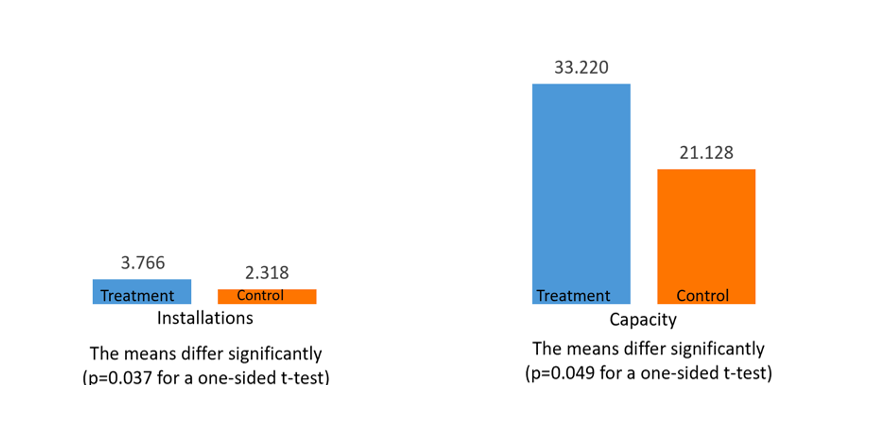Circuits of Sunlight - Marketing solar where it is most needed
First-ever circuit-level campaigns show success rates on par with town level promotional campaigns.

The Energy Information Agency (EIA) estimates that energy demand in the U.S. will continue to grow mainly due to increased demand from the residential and commercial sectors as the economy and population grow. Increasing demand can put significant pressure on-grid capacity. In response, local utility companies often grow their capacity to meet demand via expensive upgrades to substations and lines. However, investing in residential solar energy in high-value areas for the grid may have the potential to decrease pressure on certain circuits that are under stress from demand growth. For those of you not familiar with electricity system jargon, circuits are the last-mile electricity delivery networks that take electricity from a substation to the final customer. Circuits usually serve a few hundred to a few thousand people depending on the density of residential households.
The Yale-based Solar Energy Evolution and Diffusion Studies (SEEDS II) team along with the non-profit organization SmartPower, ran ten ground-breaking “Solarize” campaigns at the circuit level in the state of Connecticut. These campaigns aimed to study the value of promoting solar adoption in areas where solar could reduce the load of stressed feeders and potentially alleviate cost-shifting from increased solar adoption. These Solarize campaigns followed the lessons learned from previous Yale/SmartPower Solarize campaigns and ultimately achieved similar success rates -- showing that circuit-level campaigns can work very effectively despite involving not only smaller territories than previous campaigns, but in some cases, also in territories that cross town boundaries.
Researchers on the Department of Energy-funded SEEDS II team designed the experiment to test whether the value of solar campaigns could serve as a potential solution to significantly relieve strain on the electric grid and avoid expensive capacity upgrades. The research team selected and ran Solarize campaigns in ten treatment circuits in Connecticut. These specifically selected treatment circuits are nearing capacity and are high-value feeders for the grid. Each treatment circuit was matched with a similar control circuit where no campaigns were implemented. Comparing each set of circuits allowed researchers to isolate the effect of the campaign and control for other relevant factors.
SmartPower ran the ten Solarize campaigns in partnership with the local utility companies -- United Illuminating (UI) and Eversource. Six of the circuits fell under UI’s territory and four under Eversource’s. Furthermore, as SmartPower ran these Solarize campaign, UI ran a concurrent program called ConnectSun – in separate localities, which provided additional financial incentives to customers installing solar in two high-stress circuits*. Given the complementary goals of the Solarize and ConnectSun campaigns, the results were aggregated and analyzed together.
Results
Across the 10 circuits that had a Solarize campaign between January and June of 2019, there were on average +3.9 new installations per 1,000 people living in the circuit, which is +1.6 higher than the average of +2.3 new installations in the control group of 10 circuits. Figure 1 shows the statistically significant effects of circuit-level campaigns.
Installations increased in zip codes with Solarize campaigns compared to the control zip codes without campaigns. The effects of the campaigns at the zip code level are around +0.7 higher per 1,000 people in the Zip code when compared to the control. The effects at the circuit level are even higher with around +1.6 per 1,000 people. The increase in zip code level installations can be attributed to the circuit level campaigns directly as well as spillovers from these campaigns to others within the same zip codes as the circuits.
These results are in line with previous town-level Solarize campaigns. For example, in rounds 8-10 in Connecticut, comparing community to individual campaign efforts, there were on average +1.0 Installations per 1,000 people per campaign, which comes in just between circuit and zip code level effects.
These first-ever circuit-level campaigns show great future potential. But make no mistake -- there is much more to learn here.
As with past Solarize Campaigns, these early experiments indicate that campaigns in communities that focused on grassroots community outreach -- utilizing existing energy task forces and campaigns that used mailers with town-specific stationery -- were more successful at generating installations. Campaigns that coordinated volunteer efforts with town officials and had installer-led town meetings were also more successful. These early lessons could magnify the impact of future efforts and increase the adoption of solar in high-impact circuits, reducing stress for the grid while making solar more appealing for utility companies and consumers alike.
* You can read more about ConnectSun in our blog post here.
